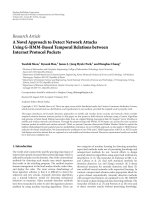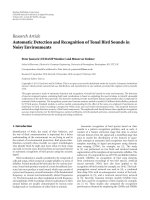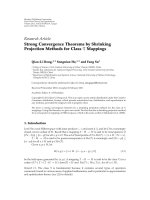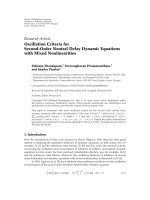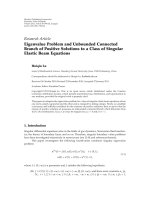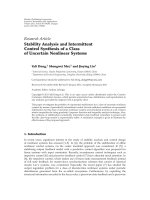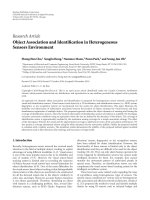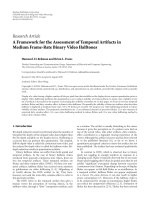Báo cáo hóa học: " Research Article Block-Matching Translational and Rotational Motion Compensated Prediction Using Interpolated Reference Frame" pptx
Bạn đang xem bản rút gọn của tài liệu. Xem và tải ngay bản đầy đủ của tài liệu tại đây (765.8 KB, 9 trang )
Hindawi Publishing Corporation
EURASIP Journal on Advances in Signal Processing
Volume 2010, Article ID 385631, 9 pages
doi:10.1155/2010/385631
Research Ar ticle
Block-Matching Translational and Rotational Motion
Compensated Prediction Using Interpolated Referenc e Frame
Ka-Ho Ng,
1
Lai-Man Po,
1
Kwok-Wai Cheung ,
2
and Ka-Man Wong
1
1
Department of Electronic Engineering, City University of Hong Kong, Hong Kong
2
Department of Computer Science, Chu Hai College of Higher Education, Hong Kong
Correspondence should be addressed to Ka-Ho Ng,
Received 26 July 2010; Revised 7 October 2010; Accepted 18 November 2010
Academic Editor: Stephen Marshall
Copyright © 2010 Ka-Ho Ng et al. This is an open access article distributed under the Creative Commons Attribution License,
which permits unrestricted use, distribution, and reproduction in any medium, provided the original work is properly cited.
Motion compensated prediction (MCP) implemented in most video coding schemes is based on translational motion model.
However, nontranslational motions, for example, rotational motions, are common in videos. Higher-order motion model
researches try to enhance the prediction accuracy of MCP by modeling those nontranslational motions. However, they require
affine parameter estimation, and most of them have very high computational complexity. In this paper, a translational and
rotational MCP method using special subsampling in the interpolated frame is proposed. This method is simple to implement
and has low computational complexity. Experimental results show that many blocks can be better predicted by the proposed
method, and therefore a higher prediction quality can be achieved with acceptable overheads. We believe this approach opens a
new direction in MCP research.
1. Introduction
Modern video coding schemes achieve high compression
efficiency by exploring the temporary redundancy between
frames via motion compensated prediction (MCP). In MCP,
a block of pixels in reference frames is chosen as prediction
candidate for the block in the current frame. Conventional
MCP assumes objects moving along the imaging plane
with translational motion, and most video coding standards
implement MCP based on this classical translational motion
model. Lots of research works are done to increase the
efficiency of translational MCP, for example, in H.264/AVC
[1], advanced block matching motion estimation algorithm
is adopted [2]. Multiple reference frames (MRF) [3]isalso
adopted to provide additional candidates for prediction over
a longer period of time. Another MCP technique is variable
block size (VBS) [4] motion compensation. These techniques
almost push the performance of translational motion-based
MCP to the limit.
However, projection of real-world moving objects onto
a 2D imaging plane will not always result in pure trans-
lational objects motion. Rotation, zoom [5], and other
nonrigid motions are also pervasive in videos. Researches
on higher-order motion models such as affine [6, 7], bilinear
[8], quadratic [9], perspective [10], and elastic [11]ones
are conducted. These higher-order motion models aim to
include nontranslational motions so that MCP prediction
accuracy can be increased at the expense of additional
motion vectors or parameters. However, these methods
require motion parameter estimations. A commonly used
method for motion parameter estimation is Gauss-Newton
minimization algorithm in which motion parameters are
iteratively updated until a minimum is found for the cost
function [12]. Motion parameter estimation is in general
of very high computational complexity. Moreover, subpixel
reconstruction is required for these higher-order motion
models because the transformed positions may not be a
sampling point of the image. Interpolation is required to
obtain the intensity values of these positions. This further
increases the computational complexity. As a result, higher-
order motion models are seldom used in practical coding
applications.
In this paper a new translational and rotational MCP
method is proposed. In this method, special subsampling in
the interpolated reference frame effectively predicts the rota-
tional block motions. In the next section, this method will be
2 EURASIP Journal on Advances in Signal Processing
Table 1: Rotation angle distribution in sequence Foreman.
Foreman (Δθ = 0.1
◦
)
Angle range
(in degree)
No. of blocks selected
RMCP
%intotal
no. of Blocks
Angle range
(in degree)
No. of blocks selected
RMCP
%intotalno.
of blocks
0.1 ∼ 1 3450 8.80% −0.1 ∼−1 3357 8.56%
1.1
∼ 2 872 2.22% −1.1 ∼−2 889 2.27%
2.1
∼ 3 468 1.19% −2.1 ∼−3 462 1.18%
3.1
∼ 4 334 0.85% −3.1 ∼−4 349 0.89%
4.1
∼ 5 170 0.43% −4.1 ∼−5 148 0.38%
5.1
∼ 6850.22% −5.1 ∼−6 111 0.28%
6.1
∼ 7930.24% −6.1 ∼−7 126 0.32%
7.1
∼ 8870.22% −7.1 ∼−8930.24%
8.1
∼ 9290.07% −8.1 ∼−9320.08%
9.1
∼ 10 25 0.06% −9.1 ∼−10 27 0.07%
10.1
∼ 11 21 0.05% −10.1 ∼−11 21 0.05%
11.1
∼ 12 16 0.04% −11.1 ∼−12 16 0.04%
12.1
∼ 13 10 0.03% −12.1 ∼−13 11 0.03%
13.1
∼ 14 11 0.03% −13.1 ∼−14 8 0.02%
14.1
∼ 15 6 0.02% −14.1 ∼−15 11 0.03%
15.1
∼ 16 7 0.02% −15.1 ∼−16 7 0.02%
16.1
∼ 17 5 0.01% −16.1 ∼−17 3 0.01%
17.1
∼ 18 5 0.01% −17.1 ∼−18 1 0.00%
18.1
∼ 19 2 0.01% −18.1 ∼−19 3 0.01%
19.1
∼ 20 5 0.01% −19.1 ∼−20 2 0.01%
20.1
∼ 21 4 0.01% −20.1 ∼−21 1 0.00%
21.1
∼ 22 2 0.01% −21.1 ∼−22 6 0.02%
22.1
∼ 23 1 0.00% −22.1 ∼−23 6 0.02%
23.1
∼ 24 1 0.00% −23.1 ∼−24 1 0.00%
24.1
∼ 25 0 0.00% −24.1 ∼−25 2 0.01%
25.1
∼ 26 1 0.00% −25.1 ∼−26 0 0.00%
26.1
∼ 27 4 0.01% −26.1 ∼−27 2 0.01%
27.1
∼ 28 0 0.00% 27.1 ∼−28 0 0.00%
28.1
∼ 29 1 0.00% −28.1 ∼−29 2 0.01%
29.1
∼ 30 7 0.02% −29.1 ∼−30 6 0.02%
30.1
∼ 30.69 0.02% −30.1 ∼−30.680.02%
Sum:
11442 29.19%
discussed in detail. In Section 3, experimental results will be
provided and discussed. In the last section, a conclusion will
be given.
2. Translational and Rotational Motion
Compensated Prediction
In theory, rotational motions are common in videos, for
example, the rotation of car wheel and waving of hand, and
so forth. Moreover, many complex motions can be modeled
by translational and rotational motion combined. Figure 1
gives an example of block matching using translational and
rotational motion model. In this example, a man is waving
his arm and the best matched block is a rotated block in the
reference frame. Figure 2 shows the rotation representation
in our motion model. As our motion model combines both
translational and rotational motion, the motion vector (MV)
representation is MV (x, y, θ), where x and y represent the
translational displacement as in traditional MCP, θ is the
rotation angle (in degree) of the block matching.
2.1. Rotated Subsampling in Interpolated Reference Frame.
Fractional-pixel accuracy MCP [13], which is adopted in the
latest video coding standards, performs block matching on
interpolated reference frames. For example, 1/4-pixel and
1/8-pixel MCP require 4 and 8 times interpolated reference
frames respectively. In [5, 14], zoom MCP is implemented by
subsampling in the interpolated reference frame. Similarly, to
implement the translational and rotational MCP, pixels in the
interpolated reference frames are subsampled in ways such
EURASIP Journal on Advances in Signal Processing 3
Table 2: Rotation angle distribution in sequence Stefan.
Stefan (Δθ = 0.1
◦
)
Angle range
(in degree)
No. of blocks selected
RMCP
%intotal
no. of Blocks
Angle range
(in degree)
No. of blocks selected
RMCP
%intotalno.
of blocks
0.1 ∼ 1 5785 14.76% −0.1 ∼−1 5648 14.41%
1.1
∼ 2 605 1.54% −1.1 ∼−2 625 1.59%
2.1
∼ 3 257 0.66% −2.1 ∼−3 282 0.72%
3.1
∼ 4 239 0.61% −3.1 ∼−4 233 0.59%
4.1
∼ 5810.21% −4.1 ∼−5820.21%
5.1
∼ 6840.21% −5.1 ∼−6710.18%
6.1
∼ 7690.18% −6.1 ∼−7630.16%
7.1
∼ 8520.13% −7.1 ∼−8580.15%
8.1
∼ 9250.06% −8.1 ∼−9280.07%
9.1
∼ 10 22 0.06% −9.1 ∼−10 29 0.07%
10.1
∼ 11 13 0.03% −10.1 ∼−11 25 0.06%
11.1
∼ 12 6 0.02% −11.1 ∼−12 18 0.05%
12.1
∼ 13 4 0.01% −12.1 ∼−13 6 0.02%
13.1
∼ 14 2 0.01% −13.1 ∼−14 13 0.03%
14.1
∼ 15 4 0.01% −14.1 ∼−15 5 0.01%
15.1
∼ 16 10 0.03% −15.1 ∼−16 4 0.01%
16.1
∼ 17 0 0.00% −16.1 ∼−17 1 0.00%
17.1
∼ 18 2 0.01% −17.1 ∼−18 4 0.01%
18.1
∼ 19 2 0.01% −18.1 ∼−19 2 0.01%
19.1
∼ 20 1 0.00% −19.1 ∼−20 3 0.01%
20.1
∼ 21 0 0.00% −20.1 ∼−21 3 0.01%
21.1
∼ 22 1 0.00% −21.1 ∼−22 2 0.01%
22.1
∼ 23 0 0.00% −22.1 ∼−23 1 0.00%
23.1
∼ 24 3 0.01% −23.1 ∼−24 4 0.01%
24.1
∼ 25 0 0.00% −24.1 ∼−25 1 0.00%
25.1
∼ 26 1 0.00% −25.1 ∼−26 1 0.00%
26.1
∼ 27 1 0.00% −26.1 ∼−27 1 0.00%
27.1
∼ 28 0 0.00% 27.1 ∼−28 5 0.01%
28.1
∼ 29 0 0.00% −28.1 ∼−29 0 0.00%
29.1
∼ 30 0 0.00% −29.1 ∼−30 3 0.01%
30.1
∼ 30.66 0.02% −30.1 ∼−30.660.02%
Sum:
14502 36.99%
that the composite reference blocks are the rotated versions
of the reference block. Block matching is then performed be-
tween these rotated reference blocks and the current picture
block. The one with the lowest distortion will be selected.
Figure 3 shows an example of the proposed MCP. The best
matchistheonewith(+1,
−2) displacement and then with a
−20
◦
rotation. The coordinates of the subsampled pixels can
be obtained by the rotation transformation equations
x
2
= cos θ
(
x
1
−x
0
)
−sin θ
y
1
− y
0
+ x
0
,
y
2
= sin θ
(
x
1
−x
0
)
+cosθ
y
1
− y
0
+ y
0
,
(1)
where θ is the rotation angle, and x
0
and y
0
are the coordi-
nates of the center of rotation, x
1
and y
1
are the original co-
ordinates, x
2
and y
2
are the rotation coordinates. The rotated
coordinates will be rounded into integers.
2.2. Computational Complexity Determined by Search Angle
Range and Interval. Interpolated reference frames exist in all
codecs which implement fractional-pixel accuracy MCP. The
rotation coordinates can be precomputed. Therefore the only
computation complexity increase in our proposed method
is the additional number of block matching between the
rotated blocks and the current block. Another overhead will
be the number of bits required to code the best matched
rotation angle. However, if we control the number of rotation
angles to be used, we can use a few bits to represent the angles
and at the same time reduce the computation complexity
required. Experiments show that up to 37% of the blocks
can be better predicted with rotational MCP. The angle of
rotation is usually small, especially for static video sequences
like Akiyo. This is reasonable as objects between frames
4 EURASIP Journal on Advances in Signal Processing
Table 3: Rotation angle distribution in sequence Akiyo.
Akiyo (Δθ = 0.1
◦
)
Angle range
(in degree)
No. of blocks selected
RMCP
%intotal
no. of Blocks
Angle range
(in degree)
No. of blocks selected
RMCP
%intotalno.
of blocks
0.1 ∼ 1 849 2.17% −0.1 ∼−1 918 2.34%
1.1
∼ 2970.25% −1.1 ∼−2 114 0.29%
2.1
∼ 3260.07% −2.1 ∼−3260.07%
3.1
∼ 4150.04% −3.1 ∼−4160.04%
4.1
∼ 540.01% −4.1 ∼−540.01%
5.1
∼ 620.01% −5.1 ∼−610.00%
6.1
∼ 710.00% −6.1 ∼−700.00%
7.1
∼ 820.01% −7.1 ∼−830.01%
8.1
∼ 920.01% −8.1 ∼−900.00%
9.1
∼ 10 2 0.01% −9.1 ∼−10 2 0.01%
10.1
∼ 11 0 0.00% −10.1 ∼−11 0 0.00%
11.1
∼ 12 1 0.00% −11.1 ∼−12 0 0.00%
12.1
∼ 13 1 0.00% −12.1 ∼−13 0 0.00%
13.1
∼ 30.60 0.00% −13.1 ∼−30.600.00%
Sum:
2086 5.32%
Best-matched
block
Reference frame Current frame
Figure 1: An example of block matching using translational and
rotational motion model.
90
◦
45
◦
20
◦
−45
◦
θ
Figure 2: Rotation representation.
usually will not rotate a lot. We define search angle interval
and search angle range so that the number of block matching
between the rotated blocks and the current block is fixed. For
asearchangleintervalΔθ, block matching will be performed
for each block-rotation of nΔθ, n
∈ Z,startingfrom0
◦
within a search angle range. For example, if the search
angle interval is 0.1
◦
and the search range is ±5
◦
,atotal
number of 10
◦
/0.1
◦
= 100 rotated block matching will be
performed. For practical implementation, we choose a lower
number of rotational searches. For example the performance
of using 16 searches in both clockwise and anticlockwise
directions, that is, 32 in total, is investigated in detail. Only
5 bits are required to represent the 32 rotational angles. For
applications requiring lower computational complexity, we
can use even fewer rotational searches. With fixed number of
searches, the search angle interval and range can be varied.
For example, search angle interval 0.1
◦
with search angle
range
±1.6
◦
and search angle interval 0.2
◦
with search angle
range
±3.2
◦
both have 32 rotational searches. By comparing
the prediction accuracy of different search angle intervals
with the same total number of searches, we found that
using a larger angle interval performs better for complex
motion sequences, for example, Foreman. For small motion
sequences, for example, Akiyo, using a smaller interval angle
has better prediction quality. This is logical because complex
motion sequences contain blocks with rotation of larger
extent. With the same number of searches, using larger angle
interval covers larger rotation. On the other hand, static
sequences contain blocks with very small rotation. For these
sequences a smaller angle of interval is more suitable. In this
stage we have not yet found a search angle interval and range
which is extremely robust. In the next section we will show
the experimental results of some typical values we tested.
The proposed MCP method can be summarized below:
Step 1. Find the best translational motion vector (MV)
in integer-pixel accuracy using traditional integer motion
estimation
EURASIP Journal on Advances in Signal Processing 5
12
15
7
11
15
14
6
10
13
5
9
16
8
12
8
3
10
2
7
4
6
3
2
13
4
11
14
16
1
1
9
5
Translational &
rotational MCP
MV ( +1,
−2, −20
◦
)
MV (+1,
−2)
Selected pixel on interpolated reference frame
Current block pixel
Figure 3: An example of translational and rotational MCP implemented by special subsampling on the interpolated reference frame.
Step 2. At the position pointed by the best translational MV
and each of its surrounding fractional-pixel accuracy posi-
tions, performs original (nonrotated) block matching and
rotated block matchings using the special subsampling
method.
Step 3. The position and the rotation angle which has the
lowest distortion is returned. This is the translational and
rotational MV (x, y, θ) which will be encoded and transmit-
ted to the decoder side.
3. Experimental Results
Experiments using CIF sequences Soccer, Stefan, Crew,
Foreman, Mobile,andAkiyo are performed to analyze the per-
formance of the proposed translational and rotational MCP.
The block size is 16
×16 pixels. The search window size is ±16
pixels. Integer-pixel motion estimation is performed using
exhaustive search (full search) algorithm, which searches
each integer position in the search window.
Because the coordinates of the subsampled pixels will
eventually be rounded into integers, some of the Δθ will be
too small such that the rounded coordinates will be the same
as that of the previous angle. To avoid repeated calculations,
we will skip those angles in our experiments.
3.1. Prevalence of Rotational Motion. To analyze the rota-
tion angle distribution, 600 differently rotated blocks are
searched, with half of them rotated clockwise and the other
half rotated anticlockwise. The angle of interval is 0.1
◦
and the rotation angles without effects are skipped. Tab l e 1
shows the percentages of rotated blocks selected (in total
number of blocks) in sequence Foreman. To reduce table
size, the rotation angles are grouped in ranges of one degree.
That is, the percentages of blocks rotated 0.1
◦
,0.2
◦
, ,to
1
◦
are summed up and tabulated in the 1st data row, the
percentages of blocks rotated 1.1
◦
,1.2
◦
, ,to2
◦
are summed
up and tabulated in the 2nd data row, and so on. From
Ta b l e 1, it can be observed 29.19% of the blocks can be better
predicted using rotational MCP.Clockwise and anticlockwise
6 EURASIP Journal on Advances in Signal Processing
750
770
790
810
830
850
870
890
SAD per block
1/2-pixel
accuracy
1/4-pixel
accuracy
1/8-pixel
accuracy
Soccer
1/16-pixel
accuracy
Translational MCP only
Translational & rotational MCP
(32 rotated search; Δθ
= 0.05
◦
)
Translational & rotational MCP
(32 rotated search; Δθ
= 0.1
◦
)
Translational & rotational MCP
(32 rotated search; Δθ
= 0.3
◦
)
Translational & rotational MCP
(32 rotated search; Δθ
= 0.5
◦
)
Figure 4: Average SAD per block in sequence Soccer.
rotations have similar distributions. That means the blocks
are not biased to a particular rotation direction. In addition,
most of the rotated blocks have small angles of rotation. 24%
of the blocks have rotation angles within
±3
◦
. Ta b l e 2 shows
the results in sequence Stefan. 36.99% of the blocks are better
predicted using rotational MCP and 33.68% of the blocks
have rotation angles within
±3
◦
. Ta b l e 3 shows the results
in sequence Akiyo. There are fewer rotation blocks selected.
5.32% of the blocks are better predicted by rotational MCP.
There is no rotation block with clockwise rotation greater
than 13
◦
selected. In anticlockwise rotation, there is also no
block selected with rotation angle greater than
−10
◦
.From
these results we can see that rotation properties vary among
sequences with different motion contents.
3.2. Optimum Search Angle Range and Interval. Figures 4, 5,
6, 7, 8,and9 compare the average SAD per block achieved
using translational-only MCP and the proposed MCP with
32 rotated searches and angles of interval 0.05
◦
,0.1
◦
,0.3
◦
,
and 0.5
◦
, under the conditions of 1/2, 1/4, 1/8, and 1/16-
pixel accuracy MCP. The lower the average SAD per block,
the better the prediction quality. We can see that in 1/2-
pixel accuracy, the improvement by rotational MCP is lower.
It is because in MCP of 1/2-pixel accuracy, the reference
frame is interpolated only two times. The rounding problem
1120
1170
1220
1270
1320
1370
SAD per block
1/2-pixel
accuracy
1/4-pixel
accuracy
1/8-pixel
accuracy
Stefan
1/16-pixel
accuracy
Translational MCP only
Translational & rotational MCP
(32 rotated search; Δθ
= 0.05
◦
)
Translational & rotational MCP
(32 rotated search; Δθ
= 0.1
◦
)
Translational & rotational MCP
(32 rotated search; Δθ
= 0.3
◦
)
Translational & rotational MCP
(32 rotated search; Δθ
= 0.5
◦
)
Figure 5: Average SAD per block in sequence Stefan.
of the coordinates of the rotated pixel is severe such that a
small change in rotation angle does not always have effect.
With higher fractional-pixel accuracy, reference frames with
higher resolutions will be available. The improvement in
prediction quality by rotational MCP can be fully reflected.
The increase of rotation angle interval from 0.05
◦
to 0.5
◦
can improve the prediction quality for sequences Soccer,
Foreman, Crew and Stefan. It is because if the rotation angle
interval is increased, with the same 32 rotated searches a
larger rotation search range can be covered. The prediction
quality can be improved because these sequences contain
large and complex motions. These motions can be better
represented by MVs with larger rotational angles. Further
increase of the rotation angle interval, for example, 0.7
◦
or
0.9
◦
, will decrease the prediction quality. It is because from
the statistical results (Tables 1 to 3)wecanseethathigh
percentage of the rotated blocks have relatively small rotation
angles. With fixed number of searches, larger angle interval
will miss these blocks and thus have lower prediction quality.
For static motion sequence Akiyo, the prediction quality
cannot be improved with larger rotation angle interval.
On the contrary, the quality is slightly dropped because
in static sequences blocks actually rotate very slightly. In
EURASIP Journal on Advances in Signal Processing 7
Table 4: Comparison of computational complexity and prediction accuracy.
Complexity Soccer Stefan Crew Foreman Mobile Akiyo
No. of 16 × 16
SAD
calculations
after Interger
ME
Average PSNR
per frame (dB)
Average PSNR
per frame (dB)
Average PSNR
per frame (dB)
Average PSNR
per frame (dB)
Average PSNR
per frame (dB)
Average PSNR
per frame (dB)
Transla-
tional-
only
MCP
TRM
CP (4
rotated
search-
es,
Δθ
=
2.0
◦
)
Transla-
tional-
only
MCP
TRM
CP (4
rotated
search-
es,
Δθ
=
2.0
◦
)
Transla-
tional-
only
MCP
TRM
CP (4
rotated
search-
es,
Δθ
=
2.0
◦
)
Transla-
tional-
only
MCP
TRM
CP (4
rotated
search-
es,
Δθ
=
2.0
◦
)
Transla-
tional-
only
MCP
TRM
CP (4
rotated
search-
es,
Δθ
=
2.0
◦
)
Transla-
tional-
only
MCP
TRM
CP (4
rotated
search-
es,
Δθ
=
2.0
◦
)
Transla-
tional-
only
MCP
TRM
CP (4
rotated
search-
es,
Δθ
=
2.0
◦
)
1/2-pixel
accuracy
8 44 30.16 30.38 26.9 26.99 32.93 33.06 34.25 34.36 26.16 26.25 43.92 43.98
1/4-pixel
accuracy
48 244 30.51 30.78 27.46 27.58 33.49 33.66 34.75 34.91 27.32 27.49 44.91 44.98
1/8-pixel
accuracy
224 1124 30.58 30.87 27.6 27.72 33.61 33.79 34.85 35.03 27.58 27.78 45.35 45.43
1/16-pixel
accuracy
960 4804 30.59 30.88 27.63 27.75 33.65 33.82 34.87 35.05 27.63 27.84 45.47 45.56
920
930
940
950
960
970
980
990
1000
1010
1020
SAD per block
1/2-pixel
accuracy
1/4-pixel
accuracy
1/8-pixel
accuracy
Crew
1/16-pixel
accuracy
Translational MCP only
Translational & rotational MCP
(32 rotated search; Δθ
= 0.05
◦
)
Translational & rotational MCP
(32 rotated search; Δθ
= 0.1
◦
)
Translational & rotational MCP
(32 rotated search; Δθ
= 0.3
◦
)
Translational & rotational MCP
(32 rotated search; Δθ
= 0.5
◦
)
Figure 6: Average SAD per block in sequence Crew.
585
595
605
615
625
635
645
655
SAD per block
1/2-pixel
accuracy
1/4-pixel
accuracy
1/8-pixel
accuracy
Foreman
1/16-pixel
accuracy
Translational MCP only
Translational & rotational MCP
(32 rotated search; Δθ
= 0.05
◦
)
Translational & rotational MCP
(32 rotated search; Δθ
= 0.1
◦
)
Translational & rotational MCP
(32 rotated search; Δθ
= 0.3
◦
)
Translational & rotational MCP
(32 rotated search; Δθ
= 0.5
◦
)
Figure 7: Average SAD per block in sequence Foreman.
8 EURASIP Journal on Advances in Signal Processing
1225
1275
1325
1375
1425
1475
1525
1575
1625
1675
SAD per block
1/2-pixel
accuracy
1/4-pixel
accuracy
1/8-pixel
accuracy
Mobile
1/16-pixel
accuracy
Translational MCP only
Translational & rotational MCP
(32 rotated search; Δθ
= 0.05
◦
)
Translational & rotational MCP
(32 rotated search; Δθ
= 0.1
◦
)
Translational & rotational MCP
(32 rotated search; Δθ
= 0.3
◦
)
Translational & rotational MCP
(32 rotated search; Δθ
= 0.5
◦
)
Figure 8: Average SAD per block in sequence Mobile.
sequence Mobile, using a smaller rotation angle interval also
has slightly better performance.
3.3. Computational Complexity of Proposed MCP Method. To
estimate the computational complexity of the proposed MCP
method in a practical system, we measured the peak signal-
to-noise ration (PSNR) achieved with four rotated searches
and angle of interval 2.0
◦
. The computational complexity of
four rotated searches with certain fractional-pixel accuracy
is similar to that of translational-only MCP with the next
higher fractional-pixel accuracy. For example the number of
SAD calculation of the proposed MCP method with four
rotated searches at 1/4-pixel accuracy is 244 because at each
1/4-pixel position four rotated and one original matching are
performed. The number of SAD calculation of translational-
only MCP with 1/8-pixel accuracy is 224 because there
are 224 search candidate positions. These two numbers are
comparable which means their computational complexities
are similar. If the proposed method with certain fractional-
pixel accuracy can achieve better prediction accuracy than
the traditional MCP with higher fractional-pixel accuracy, it
125
127
129
131
133
135
137
139
141
143
SAD per block
1/2-pixel
accuracy
1/4-pixel
accuracy
1/8-pixel
accuracy
Akiyo
1/16-pixel
accuracy
Translational MCP only
Translational & rotational MCP
(32 rotated search; Δθ
= 0.05
◦
)
Translational & rotational MCP
(32 rotated search; Δθ
= 0.1
◦
)
Translational & rotational MCP
(32 rotated search; Δθ
= 0.3
◦
)
Translational & rotational MCP
(32 rotated search; Δθ
= 0.5
◦
)
Figure 9: Average SAD per block in sequence Akiyo.
has great potential to replace traditional MCP with higher
fractional-pixel accuracy.
Ta b l e 4 shows the results. TRMCP is the proposed trans-
lational and rotational MCP. In all test sequences except
Akiyo, TRMCP with 1/8-pixel accuracy has better prediction
accuracy in terms of PSNR than translational MCP with
1/16-pixel accuracy. In Soccer, Crew,andForeman,TRMCP
with 1/4-pixel accuracy has better prediction accuracy than
translational MCP with 1/8-pixel. In 1/2-pixel accuracy, the
proposed method cannot perform better than translational
MCP with 1/4-pixel. It is because in 1/2-pixel accuracy the
rounding problem of the coordinates of the rotated pixel
is severe, as mentioned in the previous subsection. The
results also show that the proposed method works better in
sequences with complex motions, for example, Soccer and
Foreman. This matches with our assumption that complex
motions can be better modeled by the proposed translational
and rotational motion model.
4. Conclusion
In this paper, translational and rotational MCP implemented
by special subsampling in the interpolated frame is proposed.
EURASIP Journal on Advances in Signal Processing 9
It is found that up to 37% of the blocks can be better pre-
dicted with rotational MCP. The proposed method has the
merits of easy implementation and low overhead. The inter-
polated frame used by rotational MCP is the same as that
used by fractional-pixel accuracy MCP, which exists in most
recent video coding standards. Experimental results show
that higher fractional-pixel accuracies, for example, 1/16-
pixel, cannot much further improve the prediction accuracy
in translational MCP. Moreover, they require the additional
computation overhead of extra interpolation calculation.
With regard to the side information overhead, MCP with
higher fractional-pixel accuracy needs more bits to transmit
the higher fractional-pixel accuracy MV. For example the
number of candidate search positions of 1/16-pixel accuracy
MCP is around four times that of 1/8-pixel accuracy MCP.
Our proposed method only needs to transmit one rotational
angle parameter. For example four rotational angles can
be represented by 2 bits, and so on. The increase in side
information overhead is negligible.
In view of the decreasing effectiveness of MCP with
higher fractional-pixel accuracies, the proposed method
shows a new research direction to further improve the per-
formance of MCP. Further works in this direction include
the determination of an optimized search angle interval and
range which are robust for video sequences of different
motion contents. Furthermore, the correlation between the
translational MV and the rotation angle is also under inves-
tigation.
Acknowledgment
The work described in this paper was substantially supported
by a Grant from the Hong Kong SAR Government with GRF
Project no. of 9041501 (CityU 119909).
References
[1]T.Wiegand,G.J.Sullivan,G.Bjøntegaard,andA.Luthra,
“Overview of the H.264/AVC video coding standard,” IEEE
Transactions on Circuits and Systems for Video Technology,vol.
13, no. 7, pp. 560–576, 2003.
[2] A. M. Tourapis, “Enhanced predictive zonal search for single
and multiple frame motion estimation,” in Viual Communica-
tions and Image Processing, vol. 4671 of Proceedings of SPIE,pp.
1069–1079, San Jose, Calif, USA, 2002.
[3]T.Wiegand,X.Zhang,andB.Girod,“Long-termmemory
motion-compensated prediction,” I EEE Transactions on Cir-
cuits and Systems for Video Technology, vol. 9, no. 1, pp. 70–84,
1999.
[4] G. J. Sullivan and R. L. Baker, “Rate-distortion optimized
motion compensation for video compression using fixed or
variable size blocks,” in Proceedings of IEEE Global Telecommu-
nications Conference (GLOBECOM ’91), pp. 85–90, Phoenix,
Ariz, USA, December 1991.
[5] K M. Wong, L M. Po, K W. Cheung, and K H. Ng, “Block-
matching translation and zoom motion-compensated predic-
tion by sub-sampling,” in Proceedings of IEEE International
Conference on Image Processing (ICIP ’09), pp. 1597–1600,
Cairo, Egypt, November 2009.
[6] T.Wiegand,E.Steinbach,andB.Girod,“Affine multipicture
motion-compensated prediction,” IEEE Transactions on Cir-
cuits and Systems for Video Technology, vol. 15, no. 2, pp. 197–
209, 2005.
[7] R. C. Kordasiewicz, M. D. Gallant, and S. Shirani, “Affine
motion prediction based on translational motion vectors,”
IEEE Transactions on Circuits and S ystems for Video Technology,
vol. 17, no. 10, pp. 1388–1394, 2007.
[8] G. J. Sullivan and R. L. Baker, “Motion compensation for video
compression using control grid interpolation,” in Proceedings
of IEEE International Conference on Acoustics, Speech, and
Signal Processing (ICASSP ’91), vol. 4, pp. 2713–2716, Toronto,
Canada, April 1991.
[9] M. Karczewicz, J. Nieweglowski, and P. Haavisto, “Video
coding using motion compensation with polynomial motion
vector fields,” Signal Processing: Image Communication, vol. 10,
no. 1-3, pp. 63–91, 1997.
[10] Y. Nakaya and H. Harashima, “Motion compensation based
on spatial transformations,” IEEE Transactions on Circuits and
Systems for Video Technology, vol. 4, no. 3, pp. 339–356, 1994.
[11] M. R. Pickering, M. R. Frater, and J. F. Arnold, “Enhanced
motion compensation using elastic image registration,” in Pro-
ceedings of IEEE International Conference on Image Processing,
pp. 1061–1064, October 2006.
[12] B. Zitov
´
a and J. Flusser, “Image registration methods: a
survey,” Image and Vision Computing, vol. 21, no. 11, pp. 977–
1000, 2003.
[13] B. Girod, “Motion-compensating prediction with fractional-
pel accuracy,” IEEE Transactions on Communications, vol. 41,
no. 4, pp. 604–612, 1993.
[14] L M. Po, K M. Wong, K H. Ng et al., “Motion compensated
prediction by subsampled block matching for zoom motion
contents,” in ISO/IEC JTC1/SC29/WG11 MPEG2010/ M17163,
(91th MPEG Meeting), Kyoto, Japan, 2010.

